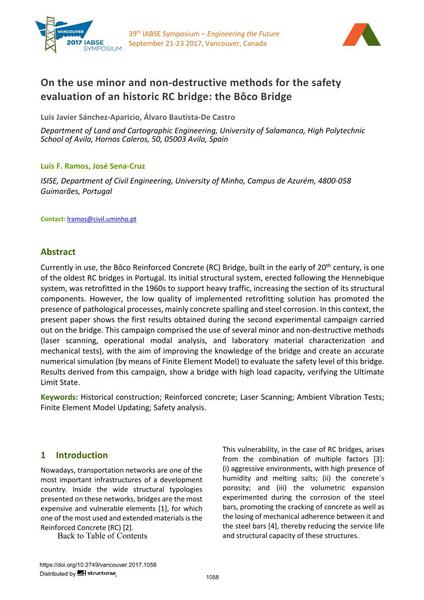On the use minor and non-destructive methods for the safety evaluation of an historic RC bridge: the Bôco Bridge

|
|
|||||||||||
Bibliographic Details
| Author(s): |
Luis Javie Sánchez-Aparicio
(Department of Land and Cartographic Engineering, University of Salamanca, High Polytechnic School of Avila, Hornos Caleros, 50, 05003 Avila, Spain)
Álvaro Bautista-De Castro (Department of Land and Cartographic Engineering, University of Salamanca, High Polytechnic School of Avila, Hornos Caleros, 50, 05003 Avila, Spain) Luís F. Ramos (ISISE, Department of Civil Engineering, University of Minho, Campus de Azurém, 4800-058 Guimarães, Portugal) José Sena-Cruz (ISISE, Department of Civil Engineering, University of Minho, Campus de Azurém, 4800-058 Guimarães, Portugal) |
||||
|---|---|---|---|---|---|
| Medium: | conference paper | ||||
| Language(s): | English | ||||
| Conference: | IABSE Symposium: Engineering the Future, Vancouver, Canada, 21-23 September 2017 | ||||
| Published in: | IABSE Symposium Vancouver 2017 | ||||
|
|||||
| Page(s): | 1058-1065 | ||||
| Total no. of pages: | 8 | ||||
| Year: | 2017 | ||||
| DOI: | 10.2749/vancouver.2017.1058 | ||||
| Abstract: |
Currently in use, the Bôco Reinforced Concrete (RC) Bridge, built in the early of 20th century, is one of the oldest RC bridges in Portugal. Its initial structural system, erected following the Hennebique system, was retrofitted in the 1960s to support heavy traffic, increasing the section of its structural components. However, the low quality of implemented retrofitting solution has promoted the presence of pathological processes, mainly concrete spalling and steel corrosion. In this context, the present paper shows the first results obtained during the second experimental campaign carried out on the bridge. This campaign comprised the use of several minor and non-destructive methods (laser scanning, operational modal analysis, and laboratory material characterization and mechanical tests), with the aim of improving the knowledge of the bridge and create an accurate numerical simulation (by means of Finite Element Model) to evaluate the safety level of this bridge. Results derived from this campaign, show a bridge with high load capacity, verifying the Ultimate Limit State. |
||||
| Keywords: |
reinforced concrete laser scanning ambient vibration tests finite element model updating Historical construction safety analysis
|
||||
